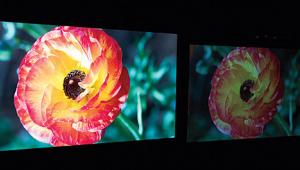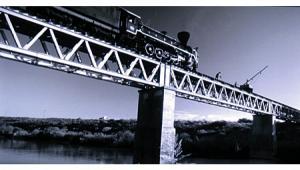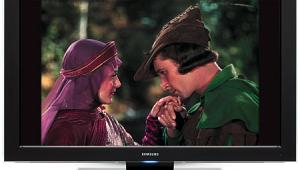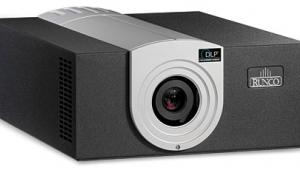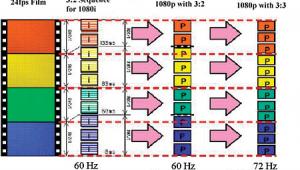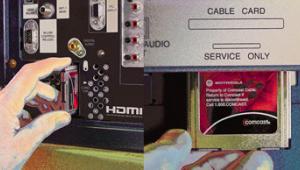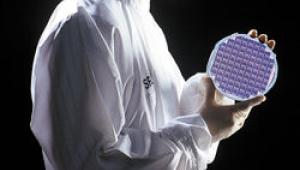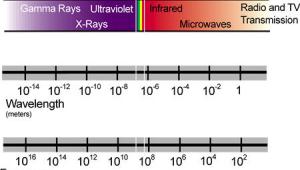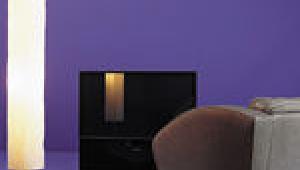The Making of a Soundtrack Page 2
All this custom recording and electronic augmentation cost a lot of money. My total sound-effects editing budget for the film was a ridiculously low $60,000, with $25,000 of that earmarked for recording. My first day on the job, I told the producer it was impossible to produce a worthwhile soundtrack for 60 grand. He said, "Hey, you're the sound supervisor—it's your job to get it done within budget!" I told him that, using traditional labor-intensive editing techniques, we'd run out of money before half the picture was completed, and that I'd therefore have to try some innovative ideas that, if they didn't work, might end up costing even more money. He just smirked.
We decided to try what was then a relatively new process: using SMPTE time code to sync videotape recorders to multitrack audiotape machines. Working with a video transfer of the film, I hoped to "punch in" sound effects electronically instead of laboriously cutting them in by hand. We'd save on labor, as well as the cost of transferring the effects from 1/4-inch audiotape to 35mm magtape. Since many of the effects would be purely electronic, we could generate them in real time to tape.

My desperate plan turned into a disaster. Tron fell way behind schedule, and the director continued to make editing changes—refusing to "lock" the film—until the bitter end. Supposedly completed reels we'd been handed for sound-effects editing kept being altered, which meant that, again and again, the day's work was down the tubes—we'd have to transfer the new "complete" reel to video and start over. Instead of a "locked" picture in November 1981, as promised for a July '82 release, film editing wasn't completed until February '82.
To make matters worse, the "final cut" included large sections of storyboard (drawings indicating where the as-yet-unfinished computer animation would go), and dozens of scenes still in the raw, black-and-white production stage. Sound effects can't be added to scenes that are still in such early form. As I'd predicted, to cut the effects in by hand in time for the final mix, a far more expensive, far more labor-intensive process had to be used, with editors working overtime and weekends—literally around the clock.
Foley: The Sound of One Hand Clapping
Foley is the process by which incidental but important sounds are added to a film's soundtrack in real time: footsteps, floors creaking, cloth brushing, keys jingling, etc. The clank of the Fugitive's leg irons as he escapes after the train wreck is a good example of Foley. The relative level of that sound in The Fugitive's mix—far louder than it would be in reality—is an example of the kind of creative license that occurs in every good film-sound mix.
Although there was no Foley budget for Tron—another absurdity—Foley had to be produced. I hired "Foley Walker" John Roesch, who'd worked on Star Wars. (In 1981, everyone I met in Hollywood had worked on Star Wars.) His job was to add footsteps and incidental sounds in both the real and computer worlds of Tron. The floor of a Foley studio contains a pit filled with concrete, sand, leaves, dirt, gravel, etc.—every conceivable surface you might see in a movie. Watching a guy put on women's high heels and "walk" to footage of a woman walking onscreen is an experience not to be missed.
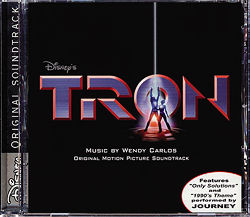 But what about footsteps in the computer world? It took a great deal of experimentation and electronic processing to get it right, but I think we did a pretty good job, especially considering that some of the final footage didn't show up until the final sound mixing was under way. Foley is important in giving a film the feel of reality—but every penny I spent on this aspect of Tron's sound was "over budget."
But what about footsteps in the computer world? It took a great deal of experimentation and electronic processing to get it right, but I think we did a pretty good job, especially considering that some of the final footage didn't show up until the final sound mixing was under way. Foley is important in giving a film the feel of reality—but every penny I spent on this aspect of Tron's sound was "over budget."
Stop the Music!
Once a film is locked, the composer sits down with the director to "spot" the picture—deciding where music goes and where it doesn't. Then begins the complex and time-consuming process of composing music, "catching" and accentuating the action onscreen. I hired synthesizer pioneer Wendy Carlos to compose the score—I wanted a combination of unearthly electronic sounds and a melodic orchestral score to "warm up" the cold computer environment.
The plan was for Carlos to compose the main themes and incidental music between August and November 1981, and then to score to the locked picture for six weeks, using her own synthesizer-filled studio and the same system of SMPTE time-code video/multitrack syncing we'd tried to use for sound-effects editing. Once her painstakingly created synthesizer tracks were completed (back then, it was one note at a time), they'd be augmented by brief orchestral overdubs.
Suffice it to say that our plans went down in flames. The supposedly locked reels Carlos had been sent were constantly being unlocked and revised, and large sections of the film still existed only in storyboard form. By mid-February '82, when the picture was finally locked for real, all of what Carlos had composed to picture had to be scrapped. Starting over at square one, she had to hastily arrange the score for orchestra and overdub synthesizer parts—precisely the opposite of what we'd originally planned.
Small orchestral sessions were recorded outside London at Walthamstow Town Hall, a venue renowned in the audiophile world for its superb acoustics. But to get the really big, dramatic sound we were after, we recorded the music at London's famous Royal Albert Hall in March 1982, using an orchestra of more than 100 musicians and the famous Albert Hall pipe organ. At one point an argument flared up between Carlos and the session producer over microphone placement. The two played tug-of-war with a copy of the score as the orchestra sat waiting and the clock ticked on. Such fun!
Back in the States, choral overdubs were recorded at UCLA's Royce Hall. Once recording was completed, Carlos mixed and edited in her home studio and overdubbed synthesizer parts onto multitrack audiotapes that were synced to videotape; to the best of my knowledge, this was the first time this technique had been used in the production of a major motion picture. Carlos's final synthesizer mixes, synced to picture, were used directly in the final mix.
Fixing It in the Mix
With all of Tron's audio elements assembled—the cleaned-up, mostly re-recorded dialog, hundreds of reels of sound effects, Foley, background ambiences, music, etc.—it was finally time to mix the soundtrack. I decided to move the mix off of Disney's Burbank dubbing stage and into Lions Gate Studios in Santa Monica—a new, state-of-the-art facility. Tron was the first Disney film mixed "off the lot," a move that didn't exactly endear me to the guys in Disney's sound department. I moved the mix because, at the time, Disney's facility was hopelessly antiquated. We were in the middle of a time crunch, and Disney's dubbing machines operated only in real time—no fast-forward, no fast rewind.
Even during the final mix, a lot of final footage was missing; we mixed to storyboard or black-and-white production footage until the final shots arrived. Background and foreground effects we couldn't have known about suddenly appeared in already mixed scenes, requiring a mad scramble of production, cutting, and pasting to create appropriate sound for the new images. Fortunately, Lions Gate's facilities included a complete sound-effects editing compound in the basement.
Even under the best conditions, mixing the sound of a film as complex as Tron is difficult and time-consuming. It takes months to mix a two-hour movie. Consider the scene in The Abyss in which a chain is used to lower and raise an underwater device. The sound-effects mixers have synced the sound of a chain drive with the picture, but the visual perspective changes throughout the scene. Sometimes the chain is in the foreground of the shot, sometimes in the background. Sometimes it's to the left, sometimes in the middle, sometimes to the right, and sometimes behind. Each shift in visual perspective must be accounted for sonically, both spatially and timbrally. And that's just one sound. Each and every sound effect must be manipulated in the mix to sound convincing in the visual context.
The same is true of every word of dialog. It takes weeks to manicure each sound, and once that's done, hundreds of elements must then be mixed together to produce a seamless, convincing sonic reality. Good mixes never sound like what they really are: hundreds of disparate elements gathered from hundreds or thousands of sources, all blended together.
During mixing, each scene must be viewed again and again, sometimes hundreds of times. Usually, so many elements are in play at any given time that submixes must be made. Of course, with today's computerized mixing consoles and digital audio workstations, the job is much easier than it was in 1982—but it's still humans who make the decisions, and humans often disagree.
Most films use one mix engineer for dialog, one for sound effects, and one for music. Unbeknownst to us, the head mixer was having personal problems during the Tron mix.
Because he was angry, he mixed a noisy, sound-effects–heavy film out of what I'd hoped would be a more music-filled soundtrack—the visually cold Tron needed all the warmth it could get, I thought. Instead, wherever music and sound effects conflicted, the engineer ditched the music in favor of jangly sound effects. At one point the director dragged me outside, where I said to him, "You'd better tell that guy to tone down the sound effects and punch up the music. Otherwise, this film's going to be awfully noisy!" His answer: "Hey, you hired the guy, you tell him what to do!" My reply: "Hey, you're the director—you tell him what to do!" In the end, the engineer did what he wanted. While it's not what I would have wanted, it's still a darn good soundtrack.
We generated a variety of mixes: a 6-track, 70mm magnetic mix (five discrete, full-frequency-range front channels plus a mono surround channel), to be used in New York and Westwood, California only; a 4-track, 70mm Dolby Stereo magnetic mix; a 4-track Dolby Stereo optical mix; and a mono mix.
Over and Out
Tron was a box-office flop. Though the concept was brilliant, the story was shaky, the script was predictable, plodding, and emotionally flat, and the acting, with the exception of Jeff Bridges, was stilted. The female lead, Cindy Morgan, was particularly awful, but there were some outstanding supporting talents, including David Warner and Barnard Hughes. Even the stiff Bruce Boxleitner did a heroic job, given the character he had to play.
The real stars of Tron were the computer animation (a first for motion pictures), the glowing special effects, the art design, the costumes, the cinematography, and (if I do say so myself) the sound. Tron was nominated for two Academy Awards: Best Sound and Best Costume Design. The film might have won for Best Sound another year, but in 1982 it was up against a little number called E.T.
While sound technology has changed dramatically in the years since I supervised the Tron soundtrack—notably the increased use of digital sound editing—the basic concepts have remained the same. The convincing, exciting, ultradynamic, 6-channel DTS and Dolby Digital soundtracks that accompany Hollywood's latest big-budget extravaganzas were created using the same basic techniques we used back in 1981 and 1982.
And even though you now know that all sounds in a movie are added after the fact and one at a time, when the lights go down you'll immediately forget all that and become lost in the story unfolding on the screen. That's what makes movies magic.


